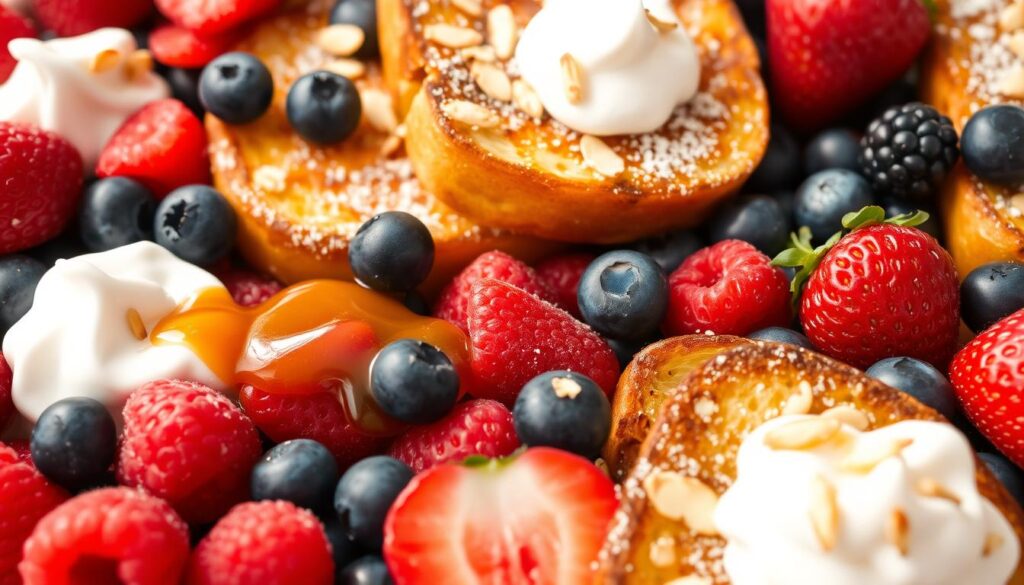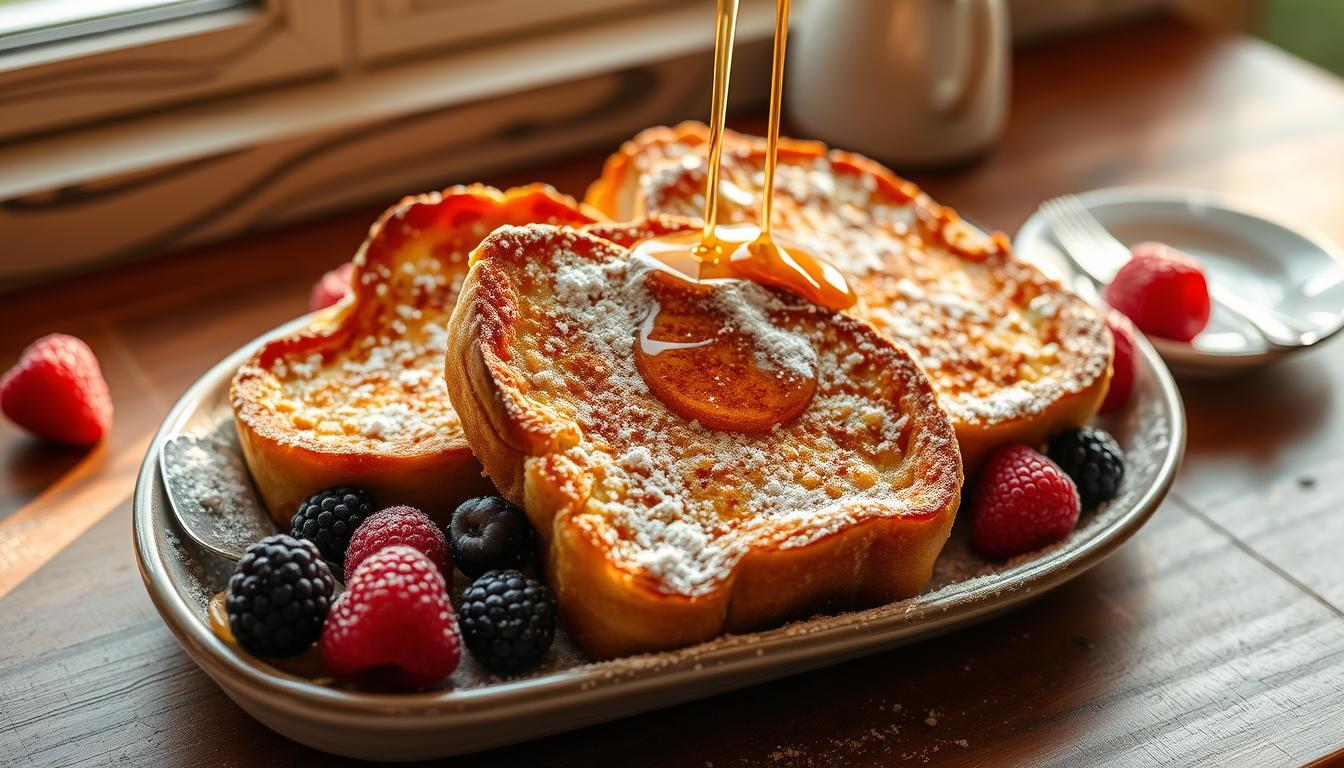Sunday mornings in my kitchen were always special. The sound of butter sizzling and the smell of cinnamon filled the air. It was a time to make memories with a perfect French toast breakfast.
French toast has been loved for generations. It’s a simple way to make a delicious meal. Whether you’re new to cooking or experienced, making French toast is sure to bring happiness to your table.
In this guide, we’ll cover everything about making the best French toast. You’ll learn how to pick the right bread and make a perfect batter. These tips will help you create a breakfast that’s truly special.
Key Takeaways
- French toast is a versatile and easy breakfast recipe
- Proper bread selection is key for great results
- Basic ingredients can make amazing flavors
- Cooking technique is as important as ingredients
- Customize your French toast with different toppings and variations
The Ultimate Guide to Perfect French Toast
French toast has been a breakfast favorite for many years. It turns simple bread into a delicious dish. Whether you’re a seasoned cook or just starting, making homemade French Toast is simple.
Let’s dive into the world of French toast. We’ll see why it’s loved by so many.
History of French Toast
French toast didn’t come from France. Ancient Romans made a version of it in the 4th and 5th centuries. They soaked bread in milk and eggs. It was a smart way to use old bread, showing the value of being resourceful in cooking.
Why French Toast Remains a Breakfast Favorite
French toast is loved for many reasons. It’s:
- Easy to make with simple ingredients
- Great for those new to cooking
- Flexible with different toppings and flavors
- A comforting, nostalgic dish
Essential Equipment Needed
To make perfect French Toast, you need a few tools:
| Equipment | Purpose |
|---|---|
| Non-stick skillet | Prevents sticking and ensures even cooking |
| Mixing bowl | For preparing the egg and milk mixture |
| Whisk | Helps blend ingredients smoothly |
| Spatula | For flipping and serving |
With these tools and a love for cooking, you’re set to make a breakfast that will impress everyone!
Essential Ingredients for Classic French Toast
Making perfect French toast begins with picking top-notch ingredients. These ingredients turn a simple breakfast into a delightful treat. The right mix of ingredients is key to a delicious French toast.
Here are the must-haves for classic French toast:
- Bread (preferably day-old or slightly stale)
- Large eggs
- Whole milk or heavy cream
- Pure vanilla extract
- Ground cinnamon
- A pinch of salt
- Unsalted butter
- Vegetable oil
“The secret to great French toast is in the quality of your ingredients and how you prepare them.”
Choose dense bread like brioche, challah, or sourdough for French toast. These types soak up the egg mixture well without falling apart. Day-old bread is best, as it’s drier and soaks up the custard better.
| Ingredient | Recommended Quantity |
|---|---|
| Large eggs | 6 eggs |
| Milk/Cream | 1½ cups |
| Vanilla extract | 2 tablespoons |
| Ground cinnamon | ½ teaspoon |
Pro tip: For the richest flavor, use full-fat milk or heavy cream. This adds a luxurious, creamy texture to your French toast. Feel free to try different ingredients to create your ideal French toast recipe!
Best Bread Choices for Your French Toast
Creating the perfect homemade French Toast starts with the right bread. You need a bread that soaks up the egg mixture well but stays firm. Knowing which breads are best is key to a great morning treat.
Professional chefs say certain breads make French toast special. The best bread is dense but absorbs liquid well.
Premium Bread Options
- Brioche: The ultimate choice for French toast
- Sweet flavor profile
- Spongy texture
- Exceptional liquid absorption
- Challah: A close second for French toast lovers
- Soft, egg-based bread
- Excellent batter absorption
- Rich, slightly sweet taste
Alternative Bread Selections
If you can’t find the usual bread, there are other options for homemade French Toast:
- Texas Toast – thick and sturdy
- Sourdough – high-protein option
- French bread – classic choice
- Sandwich bread – budget-friendly alternative
Bread Preparation Tips
When picking bread, keep these tips in mind:
- Use bread that is slightly stale or day-old
- Slice bread approximately ¾ inch thick
- Allow bread to soak 10-60 seconds per side
- Choose thick bread to prevent sogginess
Pro tip: If your bread is fresh, leave it out for a few hours to dry slightly before preparing French toast.
Whether you’re gluten-free or love all breads, there’s a perfect choice for your breakfast. Try different types to find your favorite French toast!
The Perfect French Toast Batter Recipe

Creating the ultimate French toast starts with a delicious batter. This batter turns ordinary bread into a breakfast masterpiece. Your easy brunch ideas just got an upgrade with this foolproof French toast recipe.
For the perfect batter, you’ll need a few key ingredients. These ingredients create a rich and flavorful base. Here’s what makes this recipe special:
- 3 large eggs
- 1 cup whole milk
- 2 tablespoons granulated sugar
- 1.5 teaspoons pure vanilla extract
- 0.75 teaspoons ground cinnamon
- 0.75 teaspoons kosher salt
Mixing technique is key for a smooth French toast batter. Whisk the ingredients together thoroughly. This ensures a uniform mixture that coats your bread evenly, giving you that perfect golden-brown exterior.
Pro tip: Let the batter sit for a few minutes before dipping your bread. This allows the flavors to meld together. When you’re ready to cook, dip each slice of bread for about 30 seconds per side. Make sure it’s well-coated but not soggy.
The key to great French toast is in the details – from selecting the right bread to perfecting your batter technique!
Whether you’re preparing a weekend breakfast or looking for impressive easy brunch ideas, this French toast batter recipe will elevate your morning meal. It will make it restaurant-quality deliciousness.
Secret Tips for Crispy Exterior and Fluffy Interior
Making perfect homemade French Toast is an art. It turns a simple breakfast into a special treat. Chefs focus on getting the crispy outside and soft inside just right.
The secret to great French toast is in the cooking. You want a golden-brown outside and a soft, custardy inside. Here are the key techniques to make your homemade French toast amazing.
Mastering Temperature Control
Temperature is key for French toast. Follow these tips:
- Preheat your skillet or griddle to medium heat (around 350°F)
- Use a mix of butter and oil to avoid burning
- Make sure the heat is even across the cooking area
Perfecting Bread Soaking Techniques
The right way to soak bread is important. Here are some pro tips:
- Use day-old or slightly stale bread for better soaking
- Soak each slice for 20-30 seconds
- Let excess custard drip off before cooking
Cooking Time and Visual Cues
Timing is everything for perfect French toast:
- Cook 2-3 minutes per side
- Look for a deep golden-brown color
- Make sure the inside is cooked but not dry
With these techniques, you’ll make breakfast better. You’ll impress everyone with your crispy, fluffy homemade French toast.
Creative Toppings and Garnishes

Turn your French toast into a masterpiece with exciting toppings and garnishes. Whether you want something sweet or unique flavors, there’s a topping for everyone.
Classic toppings can make your French toast even better. Try these:
- Fresh berries (strawberries, blueberries, raspberries)
- Maple syrup and butter
- Powdered sugar
- Whipped cream
- Cinnamon sugar
For adventurous flavors, check out these creative garnishes. Gourmet French toast can be made with nut butters, fruit compotes, and savory toppings.
| Category | Recommended Toppings |
|---|---|
| Fruit-Based | Caramelized bananas, berry compote, mango chunks |
| Nutty | Almond butter, toasted pecans, candied walnuts |
| Sweet Sauces | Chocolate drizzle, salted caramel, honey |
Try seasonal variations to keep your French toast fresh. Add pumpkin spice in fall or fresh citrus in summer for a tasty twist.
Sweet and Savory French Toast Variations
Take your breakfast to the next level with exciting French toast variations. These recipes turn a classic dish into a culinary adventure. Whether you love sweet or savory, these ideas will wow your taste buds and impress your guests.
French toast is a canvas for creativity. By adding unique ingredients and spices, you can make a simple breakfast into a feast for the senses.
Cinnamon Apple French Toast
Feel autumn’s warmth with this seasonal favorite. The mix of tender apples and cinnamon makes a comforting French toast, like homemade pie.
- Slice fresh apples thinly
- Sprinkle cinnamon generously
- Caramelize apples before adding to French toast
- Top with maple syrup or brown sugar
Pumpkin Spice Version
Make your French toast a fall treat with pumpkin puree and pumpkin pie spices. This version adds creamy texture and aromatic warmth to your breakfast.
- Mix pumpkin puree into egg batter
- Add pumpkin pie spice blend
- Garnish with whipped cream
- Serve with candied pecans
Gingerbread-Style Toast
Bring holiday magic to your morning with gingerbread-inspired French toast. This version combines gingerbread spices for a nostalgic breakfast.
- Use molasses in batter
- Incorporate ground ginger
- Sprinkle with powdered sugar
- Serve with cream cheese glaze
These French toast variations offer a fresh take on the classic recipe. They let you explore different flavors and create unforgettable breakfast moments.
Conclusion
Your journey to make the perfect French toast is just starting. This breakfast recipe is full of possibilities for creativity. It’s perfect for a quick brunch or a special morning meal, always impressing your guests.
French toast is great because you can make it ahead of time. You can freeze it for up to 3 months. Then, just reheat it in a toaster or oven to keep it crispy and soft.
Remember the important steps: pick the right bread, make a tasty custard, and cook it well. Alton Brown’s tips, like using stale bread and trying honey, can make your French toast amazing. Feel free to try different toppings and flavors to make it your own.
With each try, you’ll get better at making French toast. It’s a chance to improve your skills and find new flavors you love. So, get your skillet ready, choose your favorite bread, and start making breakfast memories that will last forever.

